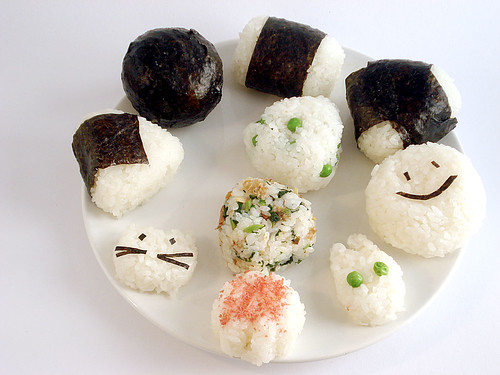Onigiri are rice balls, usually with a tasty filling. They are very portable, and therefore are very popular for carry-along lunches. Part of their appeal lies in the fact that if you're Japanese, you just love the taste of rice. It's genetic. [Edit: another word for onigiri is omusubi. I guess it just depends on what word you grew up with. In our house it was always onigiri.]
Onigiri can stand on their own, or be part of a bento or boxed lunch. (For some reason it's never just called "nigiri", though bento is also called obento, which is the honorific term.) Onigiri are also a great make-ahead snack for a crowd, since with the appropriate fillings they keep rather well. I remember my aunt making 12-cups of rice worth of onigiri at a time for the large family gatherings at New Year's or Obon (August festival to pay respect to our ancestors). Her hands would be bright red from the heat of the rice. She favored salted salmon (shio zake) as the filling usually - very salty salmon in fact.
Onigiri is also one of my top comfort foods. It reminds me of the ones my mother used to make for me for school outings (ensoku) as well as countless school lunches. When we stayed at my grandmother's and my cousines and I would take trips to the Chichibu mountain area, my aunt would make huge rice balls to assuage our appetites. There's a comforting feeling of continuity with history too, because Japanese travelers have sustained themselves on those salty rice balls for hundreds of years.
Like obento boxed lunches, onigiri can be elaborate creations, but the simple versions the are best in my opinion. We often bring some onigiri with us on long train trips: it's a lot better than buying the overpriced sandwich buns from the vending carts. Yes, sometimes people look at us curiously as we bite into those soccer-ball colored balls. We don't care one bit.
While I was working on writing up this entry, I came across this post by Mimi Ito . Japanese people have a lot of emotional attachment to obento, and to onigiri too.
Classic Onigiri
For 4 fair sized rice balls, you need:
- 4 cups of freshly cooked Japanese-style rice (What kind of rice can you use? See Looking at different types of rice. No, you cannot use long-grain, jasmine, basmati, or Uncle Ben's.)
- 2 sheets of nori seaweed, cut into 3cm/2 inch wide strips
- Salt
- Fillings. Some classic fillings are pickled plum (umeboshi), bonito flakes just moistened with soy sauce (okaka), bonito flakes mixed with pickled plum (umekaka), flaked cooked salted salmon (shake or shiozake), cooked salty cod roe (tarako), chopped up pickles (tsukemono), and tsukudani, various tidbits - bonito cubes, tiny clams, etc. - cooked and preserved in a strong soy-sugar-sauce. Some non-traditional fillings that work well are described below.
The key to making good onigiri is to have freshly cooked, hot rice. You can't make good onigiri with cold rice.
Wet your impeccably clean hands with cold water, and sprinkle them with salt. Take 1/4th of the rice and place on one hand. Make a dent in the middle of the rice with your other hand. Put in about 1 tsp or so worth of filling in the dent.
Working rapidly, wrap the rice around the filling, and form into a ball. To make the traditional triangular shape, cup your hand sharply to form each corner, and keep turning it until you are happy with the shape. Practive makes perfect.
Wrap the rice ball with 1-2 strips of nori seaweed.
Repeat for the rest of the rice.
To bring along on picnic, wrap in plastic film or in a bamboo leaf (which is traditional). Some people prefer to carry the nori strips separately, and to wrap them around the onigiri when eating, to preserve the crisp texture of the seaweed.
If it's hard to get a hold of the traditional fillings, here are some non-traditional ones that I have tried that work well. However, unlike the more traditional fillings (especially umeboshi) these fillings are quite perishable, so be careful in hot weather if you are taking them for a picnic. Any rather strongly flavored, salty filling should work.
- Ground meat (pork or beef or a mixture), cooked with grated or chopped ginger, then flavored with soy sauce, some red pepper flakes, sake or mirin, and sugar. It should be quite dry. Curry flavored ground meat mixture works surprisingly well too.
- Canned tuna, well drained and flaked, flavored with a bit of soy sauce and/or salt to taste.
- Flaked corned beef
- Chopped up western style pickles (as long as they don't have too much garlic in the brine), well squeezed to get rid of excessive moisture
For a fairly well-rounded picnic lunch that can all be eaten without utensils, add hard-boiled eggs (with a twist of salt) or cold barbeque chicken or skewered chicken (yakitori), an apple or orange, and vegetable sticks (carrot sticks, celery sticks, cucumber sticks).








0 ความคิดเห็น:
แสดงความคิดเห็น